
Susan Silton. In everything there is the trace, 2013. Installation view at the USC Fisher Museum of Art. Photo: Alexandra Brown.
A funny thing happened in Los Angeles recently. Two different artists, with only a passing knowledge of one another’s practices, each undertook high-profile performance projects that involved the laborious retyping of iconic works of literature on manual typewriters. Susan Silton, as part of the installation In everything there is the trace, included in a group show called Drawn to Language at the University of Southern California’s Fischer Museum of Art, organized multiple shifts of people to help her retype the entirety of John Steinbeck’s The Grapes of Wrath. Tim Youd, meanwhile, continued an epic series of solo performances in which he retypes great novels at locations germane to the plot or the life of the author; for example, Charles Bukowski’s Post Office was typed outside of the Los Angeles Terminal Annex post office, where the author’s fourteen years of service provided the source material for the book.
With both of these projects occurring in the fall of 2013, this micro-trend got local art-world followers wondering: Just what were these artists trying to accomplish? What was it about retyping old novels on old equipment that was so attractive to them? What, if anything, came out of the effort?
The only thing more curious than these projects’ coincidental occurrence is the fact that they couldn’t possibly be more different from one another; anyone who thinks that one artist might have stolen the idea from the other will be disabused of the notion once she gets to know the works more intimately. Silton’s installation, which included other typing pieces that she had executed on her own, emphasized social and political engagement, touching heavily on labor issues; the Steinbeck retyping used a collaborative approach that emphasized collective awareness. Youd, however, has undertaken more of a classic hero’s journey, traveling the world alone in a quest to retype one hundred great novels over a five-year period. All of the novels are ones he has read and loved, and the project is partly intended as an investigation of his fondness for his boyhood literary heroes.
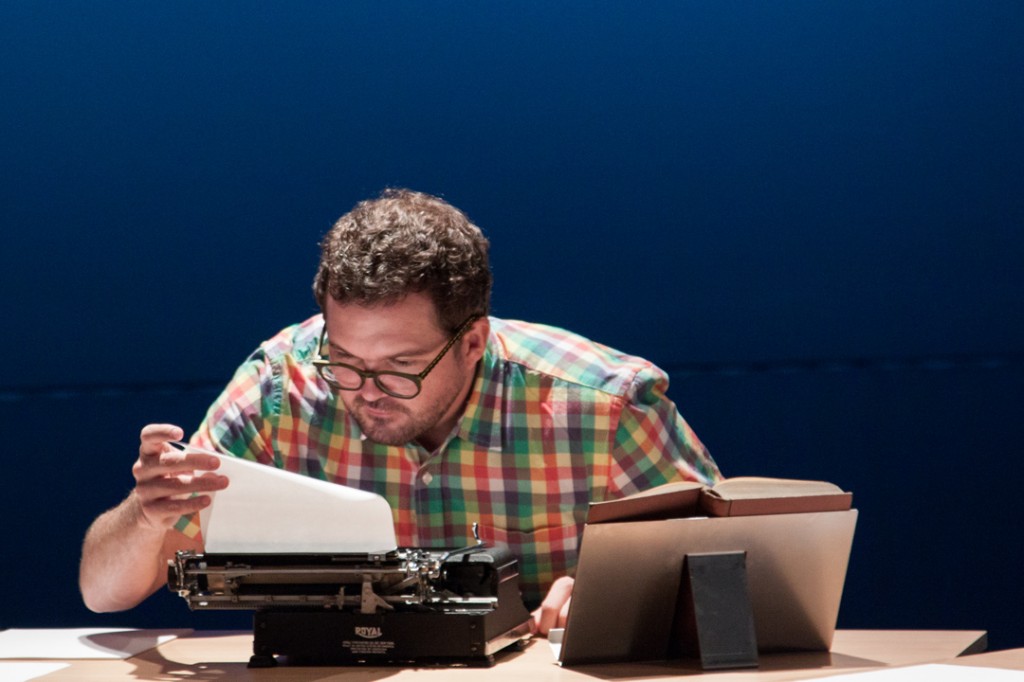
Susan Silton. In everything there is the trace, 2013. Installation view at the USC Fisher Museum of Art. Photo: Alexandra Brown.
I joined Silton on one of her “type-ins” in October. A special collective typing table had been built for the project, composed of a circle of ten interlocking individual tables. An array of vintage typewriters populated the workstations along with copies of The Grapes of Wrath and sheets of paper that had already been typed on by previous participants. Our instructions were to resume typing where the last typist had stopped and to type continuously for about an hour. Adding a surreal element to the proceedings, our typing was done in stencil mode, meaning that there were no ribbons in the machines, and the typing produced nothing but indentations on the page. All of Silton’s typing projects utilize this method; she says, “Typing without ink leaves only the trace of the activity, which foregrounds the act of rereading even further.”
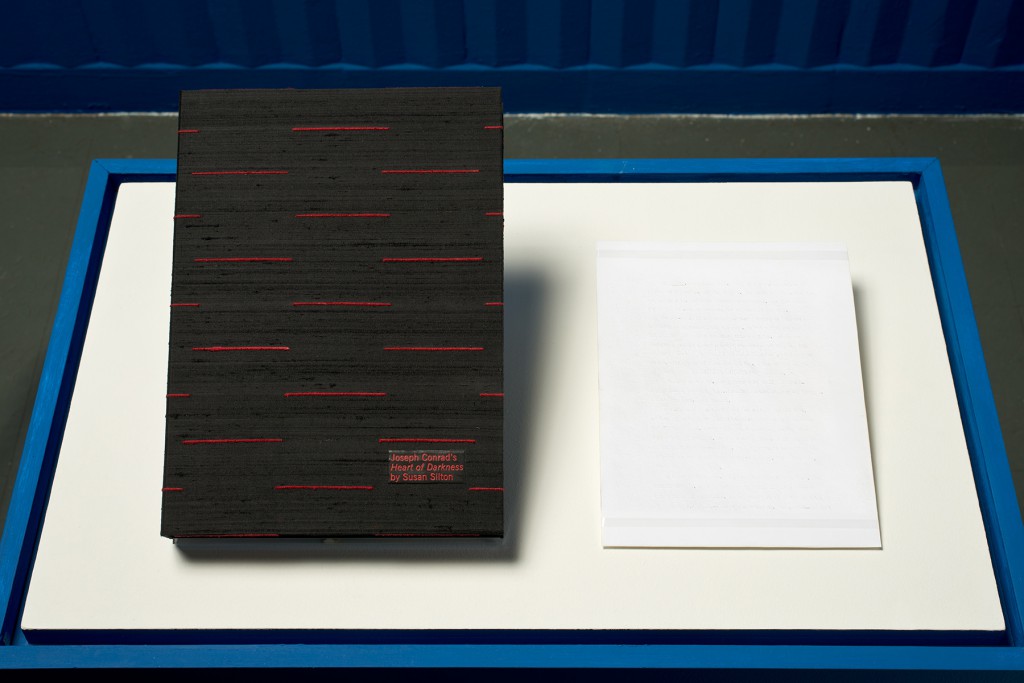
Susan Silton, Joseph Conrad’s Heart of Darkness, 2007. Photo: Brian Forrest
In retyping, Silton’s primary interest is in rereading the text with intention. In 2007, she executed her first stencil project when she retyped Joseph Conrad’s Heart of Darkness as a response to the United States’ invasion of Iraq. She was attracted by the heavy physicality and residue left behind by a manual typewriter. In a more recent series called Appraisals, she extracted from auction catalogs the captions for works of art valued over one million dollars; she then typed poems about labor and class struggle over the captions. For example, a caption for a Jeff Koons was overlaid with almost invisible words from Audre Lorde’s “A Song for Many Movements.”
During the type-in, as I struggled to get used to the leaden feel of the ancient typewriter, I found myself engaged in a mental staging of the text, as I found that the easiest way for me to proceed was to memorize a sentence first and then go back to the typewriter to transcribe it. The keys were simply not responsive enough for me to move quickly through the process without looking at them, not to mention the margins and carriage returns to worry about. At the same time, I gleaned a sense of continuity, of simply being one person in a procession of persons engaged in the same task, as well as one of futility, as continued strokes on the page produced nothing clearly visible to the eye. When our typing time was up, we all stopped and spent a few minutes sharing our experiences with one another.
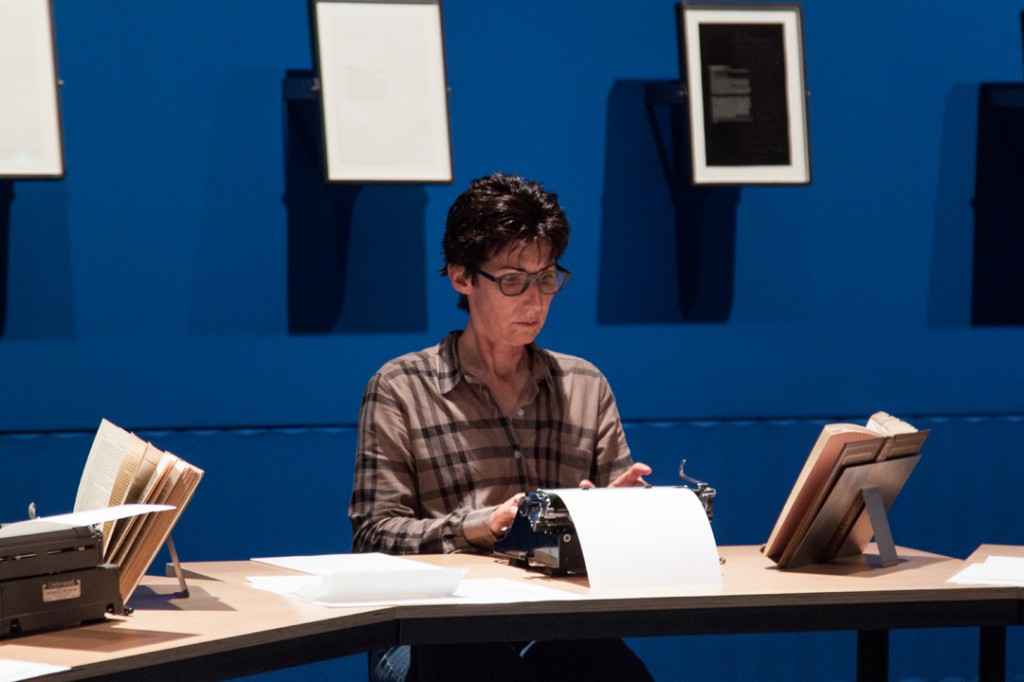
Susan Silton retypes The Grapes of Wrath as part of In Everything There Is the Trace at the USC Fisher Museum of Art, 2013. Photo: Alexandra Brown
There was no such collective labor dynamic when I went to visit Youd at Grand Central Art Center (GCAC) in Santa Ana, a month later. He was in the midst of a two-week residency in which he was typing Philip K. Dick’s A Scanner Darkly, a dystopian novel set in Orange County. Dick wrote the book while he was living in Santa Ana, and he died there not long after the book’s publication.
Sitting at a small table in the reception area of GCAC, Youd spent several hours a day alternately typing and conversing with visitors. Like Silton, Youd employs a twist in his typing method—for each novel, he uses only one sheet of paper, and one sheet of backing paper, that he feeds into the typewriter over and over again. The result is a sheet that is almost entirely coated in black ink and another that bears the impressions of the type of the first sheet. Youd takes these two sheets and frames them as a diptych, which becomes the primary artifact of the performance. He also makes a wall-mounted sculpture that depicts the typewriter he used (chosen to approximate the model that the novel’s author would have used), sometimes with a selection of the novel’s text visible on a sheet on the roller. At GCAC, several of these diptychs and sculptures were mounted on the walls behind his desk, serving as a backdrop to his performance.
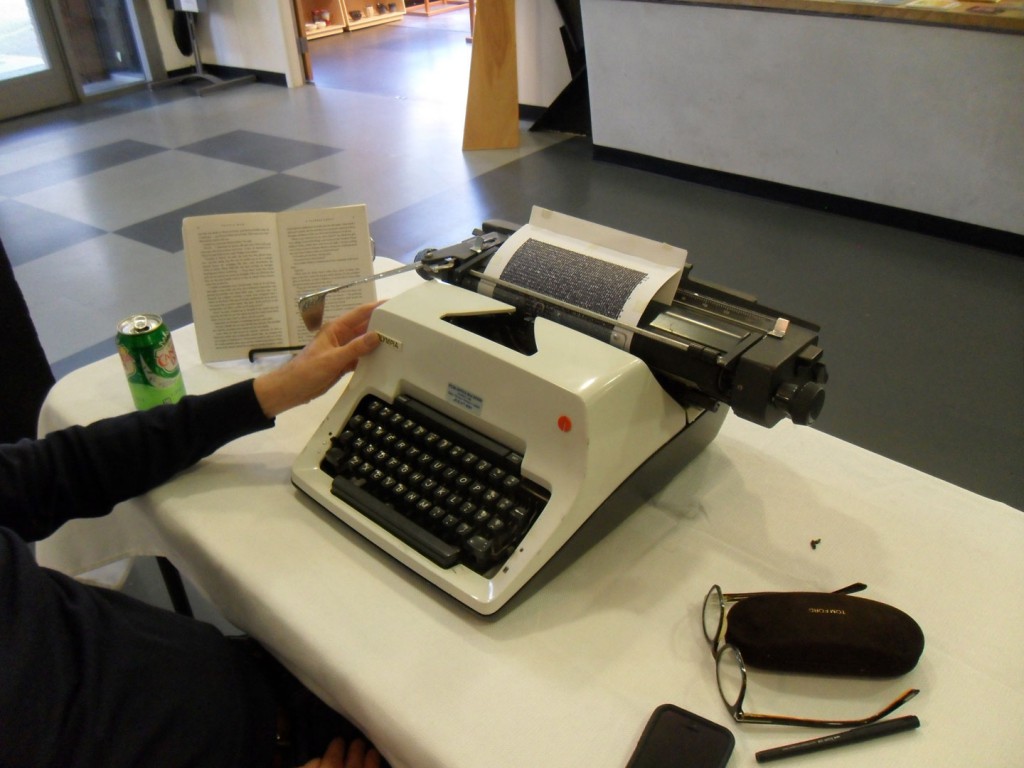
Tim Youd’s workstation at Grand Central Art Center in Santa Ana, where he typed Philip K. Dick’s A Scanner Darkly, November 2013. Photo: Carol Cheh
Asked why he initiated this grueling project, Youd said, “As a society, we sometimes seem to be more interested in the monuments to literature than the literature itself. People go to Key West to see the Hemingway House and its polydactyl cats, or the one-hundred-twenty-foot scroll on which Kerouac wrote On the Road, but are they doing the heavy lifting of understanding the novels? The shrines are packaged as entertainment, and they are fun, but there is an element of laziness there. So I thought, why not flip this and fetishize the fetishization, if you will—dive into the substance of the fetish and inhabit it? If I am typing the work on the same kind of typewriter that the author used, am I then closer to the work?”
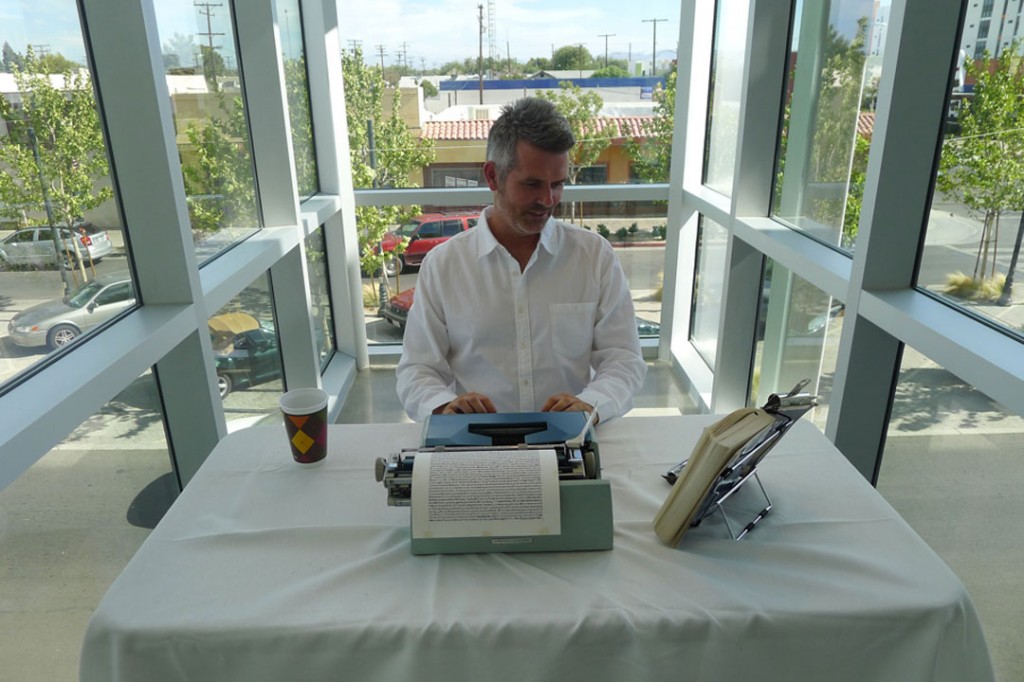
Tim Youd re-typing Tom Wolfe’s The Right Stuff in Lancaster, California at the Lancaster Museum of Art and History, August 2013. Photo: Coagula Archives
Youd is obviously a literature geek, and this project taps directly into his own fandom. Interestingly, it is also turning him into a minor celebrity; the performances have received critical and popular attention, and Youd’s number of appearances is growing as he travels to locations both banal and exotic to retype different novels. Indeed, it might be said that the artist has achieved his objective and become a fetish object himself. In January, he announced that he would be retyping all seven of Raymond Chandler’s Phillip Marlowe novels at various locations throughout Southern California. The performances will then culminate in his first solo museum show at the Museum of Contemporary Art, San Diego. Since Chandler spent the last decade of his life in La Jolla, minutes from the museum, it is a fitting and monumental place to conclude this segment of the project.
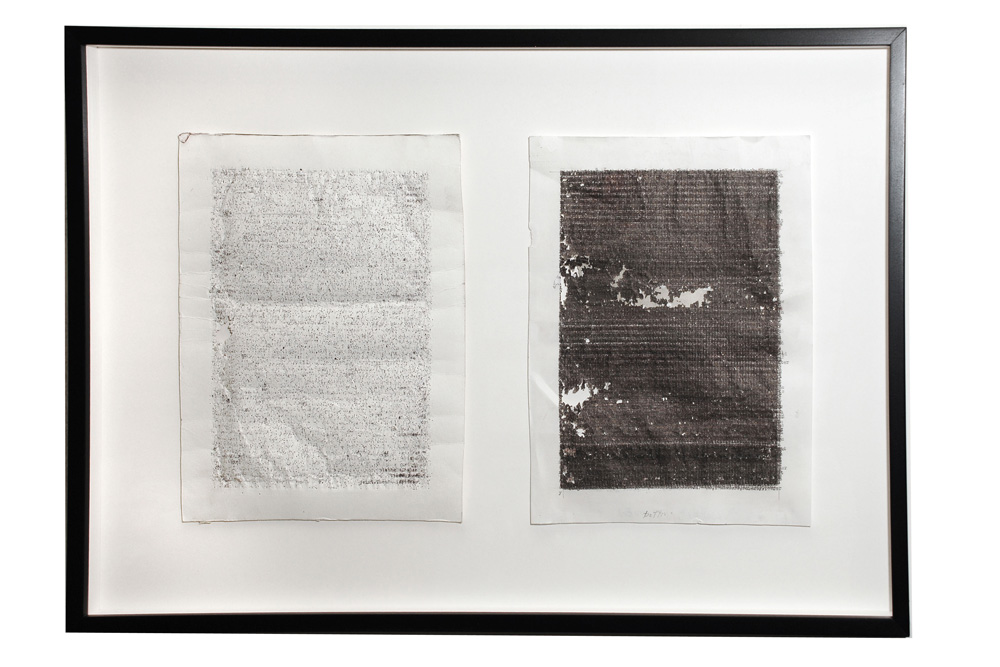
Tim Youd, Charles Bukowski’s ‘Women’, 304 pages typed on Olympia SG-1,” 2013. Courtesy the artist and Coagula Curatorial
While Silton’s and Youd’s projects are radically different from one another in terms of intention, artistic lineage, and social reception, both are noteworthy for producing formally and conceptually exquisite works of text-based art. Youd’s diptychs are robust modernist compositions that remind one of the canvases of Ad Reinhardt and Lucio Fontana while Silton’s sheets of ghostly markings are layered objects that express very concrete criticisms of the material world. Though they produce nothing absolutely new, both projects generate objects of significant beauty.




Pingback: Letter from the (Guest) Editor: Translating Translation | Art21 Magazine